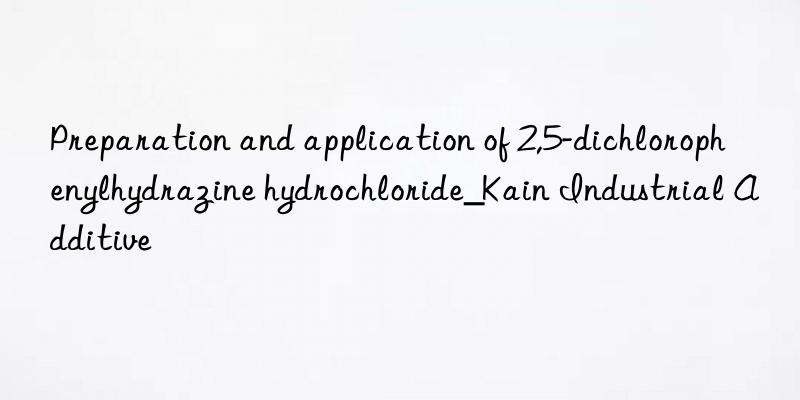
Background and overview[1][2]
2,5-Dichlorophenylhydrazine hydrochloride is an organic chemical substance that can be used as an organic intermediate.
Preparation[1]
Under nitrogen protection, add concentrated hydrochloric acid (120 ml, 32%, 1.2 moles) into a 500ml bottle, then lower the temperature to -2 to 0°C and stir at low temperature. Then 2,5-dichloroaniline (20 g, 123 mmoles) was added in one portion. Keeping at -2 to 0°C, dissolve sodium nitrite (10.2 g, 0.148 moles) in water (20 ml) and slowly add it dropwise to the above acidic system. Continue stirring for one hour after the addition. Vitamin C (22.8 g, 0.129 moles) was added to the above system in batches. Then raise to room temperature (18-20°C), continue heating to 40°C, and keep for 2 hours. Finally, bring to room temperature (18-20°C) and add water (50 ml). The above mixed system was stirred at 20-25°C for 16 hours, filtered, and the filter cake was washed with water to obtain an oxalic acid intermediate with a wet weight of 110 g. 108 g of oxalic acid intermediate was suspended in concentrated hydrochloric acid (160 ml) and water (90 ml), and stirred at 90°C for 2 hours. The orange suspension was brought to room temperature 20-25°C and stirred for 16 hours. Filter and dry to obtain 22.4 g of yellow solid 2,5-dichlorophenylhydrazine hydrochloride hydrate (HPLC: 98.3%; yield: 71%).
Apply[2]
CN201610788072.6 reported that 2,5-dichlorophenylhydrazine hydrochloride can be used to synthesize a phenylpyridazinone derivative 2-(2,5-dichlorophenyl)-6 shown in the figure below -(3-(4-(6-fluorobenzene[d]isoxazol-3-yl)piperidin-1-yl)propoxypyridazin-3(2H)-one.
1) Dissolve 16.2g of 2,5-dichlorophenylhydrazine hydrochloride and 9.8g of maleic anhydride in 200ml of purified water. While stirring, slowly add 40 ml of concentrated hydrochloric acid. After the addition is complete, heat to reflux and react for 6 hours. After the reaction was completed, the mixture was cooled in an ice-water bath and a yellow solid precipitated. Filter with suction and wash the filter cake twice with water. Take out the filter cake and dissolve it with saturated NaHCO3, filter out the insoluble matter, adjust the clear liquid to a pH value between 2 and 3 with concentrated hydrochloric acid, and precipitate a white solid. After suction filtration and drying, 15.8g is obtained, with a yield of 76.7%.
2) Take 10.4g of the product from the first step, 13.8g of anhydrous potassium carbonate, and 18.8g of 1,3-dibromopropane, add 100ml of acetone, heat to reflux for 4 hours, cool to room temperature, filter, and evaporate the solvent to dryness. A light yellow oil was obtained, and 9.8 g of brown oil was obtained through flash chromatography column, with a yield of 60.2%.
3) Take 1.60g of the second step product, 1.0g of 2,5-dichlorobenzo[d]isoxazole-3-piperidine hydrochloride, and 2.0g of potassium carbonate, add 50ml of acetonitrile, and heat to reflux the reaction 6 hours, cool to room temperature, evaporate the solvent to dryness, add an appropriate amount of methylene chloride, wash with water, separate the aqueous layer, add anhydrous magnesium sulfate to the organic layer to dry, evaporate the solvent to dryness, and obtain a yellow oil, which is light yellow after flash chromatography. 1.77g of oil, yield 76.0%.
Main reference materials
[1] WO2002044133A1
[2] CN107793362



 微信扫一扫打赏
微信扫一扫打赏
